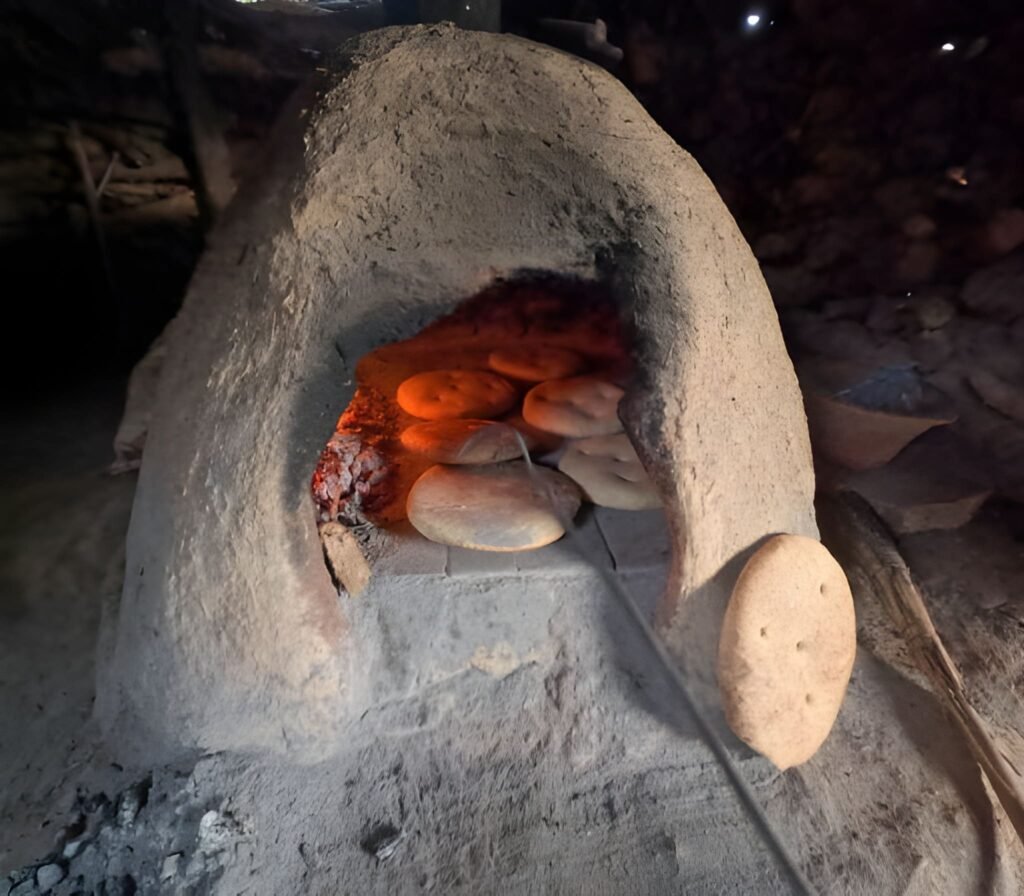Bread Before Ovens: A Story by the Fire
Picture this: you’re sitting by a campfire thousands of years ago. The air is filled with the smoky scent of burning wood. Someone flattens dough between their palms and places it carefully on a heated stone. Within minutes, the bread puffs slightly, the edges crisp, and the smell makes your stomach growl. There’s no oven in sight, only fire, stone, and human creativity.
This is the origin of bread as we know it. The ancient bread-baking methods people developed weren’t fancy, but they were ingenious. They turned simple mixtures of flour and water into one of humanity’s oldest and most universal foods. And the best part? Many of these methods still exist today in cultural traditions, from Indian chapatis to Middle Eastern naan.
Why Ancient Bread Baking Methods Still Matter
Bread is more than food—it’s a symbol of survival, community, and culture. Understanding how people baked bread without ovens teaches us a few powerful lessons:
-
It shows human resilience and innovation.
-
It connects us to traditions that shaped civilizations.
-
It explains why some cultural breads—like tortillas or flatbreads—still don’t require ovens today.
-
It reminds us that simplicity often creates the best flavors.
For archaeologists and historians, early bread is a clue to humanity’s shift from hunting and gathering to agriculture. For modern bakers, it’s proof that flavor and tradition don’t always come from machines.
Ancient Bread Baking Methods Across Cultures
1. Baking on Hot Stones
One of the simplest and oldest methods was pressing dough onto stones heated by fire. Archaeologists discovered charred crumbs of flatbread in Jordan that are 14,000 years old (Smithsonian research). Imagine prehistoric people grinding wild grains and baking them directly on rocks—long before farming existed. Today, pizza stones and flatbreads echo this ancient practice.
2. Using Clay Pots and Earthen Ovens
Clay was a game-changer. People placed dough inside heated clay pots or lined earthen ovens with dough. The Middle Eastern tandoor oven, which bakes naan and pita, is a direct descendant of these techniques. The clay trapped heat, creating a crispy outside and soft inside.
3. Baking in Ashes
Romans, soldiers, and nomads often buried dough under ashes and hot embers. The slow, smoky heat produced rustic loaves. Ash bread was cheap, efficient, and portable, a survival tool for armies and travelers. Some Mediterranean villages still make ash bread as a local specialty.
4. Flat Griddles and Early Metalwork
Once people mastered metal, they used flat griddles or pans over an open fire. This method birthed flatbreads like chapatis in India and tortillas in the Americas. Even today, these breads are central to daily meals—proof that ovens aren’t always necessary.
5. Communal Hearths and Shared Ovens
By the Middle Ages, not every household had an oven. Villages often shared large communal hearths, where families brought their dough to bake. This wasn’t just practical; it built community. Bread became more than sustenance; it was a shared ritual.
Table: Comparing Ancient Bread Baking Methods
| Method | Technique Used | Example Breads | Modern Equivalent |
|---|---|---|---|
| Hot Stones | Dough placed on heated rocks | Prehistoric flatbreads | Pizza stone baking |
| Clay Pots / Tandoor | Dough baked in clay pots or ovens | Naan, pita | Tandoor ovens, pizza ovens |
| Ash Baking | Dough buried under embers and ashes | Roman ash bread | Campfire bread |
| Metal Griddles / Comals | Dough cooked on heated iron/stone pans | Tortillas, chapatis | Cast-iron griddle |
| Communal Hearths | Villagers shared clay or brick ovens | Medieval rustic loaves | Wood-fired bakeries |
Experience: Baking Without Ovens
I once tried baking flatbread on a camping trip using only a heated stone. At first, the dough stuck and burned, but with patience, the second piece puffed up beautifully. The smoky flavor was unlike anything from a modern oven.
In Ethiopia, families still bake injera on clay griddles heated by fire. In Mexico, tortillas are made on comals, just like their ancestors did thousands of years ago. In Italy, wood-fired pizza is a global icon rooted in the same principle. These traditions prove that the old ways are still the best ways for flavor.
What Experts and History Tell Us
National Geographic notes that early breads were probably accidental—grain porridge spilled onto hot stones, hardened, and tasted delicious. From there, humans repeated and refined the process.
The Smithsonian reports that bread remains from 14,000 years ago predate farming, showing that bread may have inspired agriculture, not the other way around. Medieval cookbooks like The Forme of Cury (14th-century England) describe rustic loaves baked in communal ovens, underscoring bread’s role in daily life.
These records reveal that bread wasn’t just food it was innovation, community, and survival rolled into one.
Why We Still Love Ancient Bread Baking Methods
So why, in a world of high-tech appliances, do people still seek out wood-fired pizza, clay-oven naan, or stone-baked sourdough?
-
Flavor: Fire, clay, and stone add smoky, earthy notes machines can’t replicate.
-
Texture: Ancient methods create unique crusts and crumb structures.
-
Heritage: Breads baked without ovens connect us to cultural roots.
-
Trend: Artisan bakeries thrive on reviving these “old” techniques.
It’s not nostalgia it’s about taste and tradition that never lost relevance.
What This Really Means
When you step back, the story of ancient bread baking methods isn’t just about food—it’s about humanity. It’s about families gathering around fire, neighbors sharing ovens, and cultures shaping identity through bread.
The tools may have changed, but the essence hasn’t. Every time you enjoy flatbread on a griddle or pizza from a stone, you’re eating history. You’re connected to the same ingenuity that kept our ancestors alive and thriving.
FAQs on Ancient Bread Baking
Q1: What’s the oldest bread ever found?
Archaeologists discovered 14,000-year-old flatbread remains in Jordan.
Q2: Did every culture bake bread the same way?
No. Techniques varied—stones in prehistoric Europe, clay pots in Asia, griddles in the Americas.
Q3: Can I bake bread today without an oven?
Yes! Use a cast-iron skillet, pizza stone, fire pit, or even bury dough under campfire ashes.



